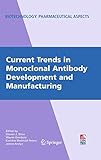Current Trends in Monoclonal Antibody Development and Manufacturing / edited by Steven J. Shire, Wayne Gombotz, Karoline Bechtold-Peters, James Andya.
Tipo de material: TextoSeries Biotechnology: Pharmaceutical Aspects ; XIEditor: New York, NY : Springer New York : Imprint: Springer, 2010Descripción: xiv, 354 páginas recurso en líneaTipo de contenido:
TextoSeries Biotechnology: Pharmaceutical Aspects ; XIEditor: New York, NY : Springer New York : Imprint: Springer, 2010Descripción: xiv, 354 páginas recurso en líneaTipo de contenido: - texto
- computadora
- recurso en línea
- 9780387766430
- RC321-580
Springer eBooks
Design Of Therapeutic MABS -- CDR Repair: A Novel Approach to Antibody Humanization -- Nanobodies, Single-Domain Antigen-Binding Fragments of Camelid Heavy-Chain Antibodies -- Expression and Production of MABS -- GPEx® A Flexible Method for the Rapid Generation of Stable, High Expressing, Antibody Producing Mammalian Cell Lines -- Advancing Our Cell Culture Platform: Incorporating Lessons Learned and New Technologies -- Recovery and Purification -- Addressing Changes Associated with Technology Transfer: A Case Study -- Concepts for Disposables in Biopharmaceutical Manufacture -- Formulation and Delivery -- Formulation and Delivery Issues for Monoclonal Antibody Therapeutics -- Challenges in the Development of High Protein Concentration Formulations -- Protein Immobilization by Crystallization and Precipitation: An Alternative to Lyophilization -- Analytics and Specification Setting for MABS -- Characterizing High Affinity Antigen/Antibody Complexes by Kinetic and Equilibrium Based Methods -- Analytical Characterization of Monoclonal Antibodies: Linking Structure to Function -- Analysis of Irreversible Aggregation, Reversible Self-association and Fragmentation of Monoclonal Antibodies by Analytical Ultracentrifugation -- Biophysical Signatures of Monoclonal Antibodies -- Pharmacokinetics and Immunogenicity -- Impact of Fc Glycosylation on Monoclonal Antibody Effector Functions and Degradation by Proteases -- Immunogenicity Assessment of Antibody Therapeutics -- Armed Antibodies and New Classes of Antibodies -- Production of Monoclonal Antibodies in E. coli -- Recent Advancements in the Use of Antibody Drug Conjugates for Cancer Therapy -- Antibody Radiolabeling.
Monoclonal antibodies represent one of the fastest growing areas of new drug development within the pharmaceutical industry. Several blockbuster products have been approved over the past several years including Rituxan, Remicade, Avastin, Humira, and Herceptin. In addition, over 300 new drugs are currently in clinical trials. With both large, established biotechnology companies and small start-ups involved in the development of this important class of molecules, monoclonal antibodies products will become increasingly prevalent over the next decade. Recently the regulatory review of monoclonal antibodies has been moved from Center for Biologics and Research to the Center for Drug Evaluation and Research (CDER) division of the US Food and Drug Administration. It is anticipated that CDER will expect a certain minimal amount of data to be provided as more of these products move through the regulatory pipeline. Current Trends in Monoclonal Antibody Development and Manufacturing will provide readers with an understanding of what is currently being done in the industry to develop, manufacture, and release monoclonal antibody products and what will be required for a successful regulatory submission.
Para consulta fuera de la UANL se requiere clave de acceso remoto.


